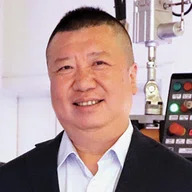


Follow us on:
CONTACT US | Download the 2021/2022 issue | ©Atlas Copco AB
result
Search
A MAGAZINE FROM ATLAS COPCO GROUP
Sustainable technologies
Markets
Smart manufacturing
Our culture
Service and Consulting
Energy efficiency
Gateway to
GROWTH
With a continuing focus on construction, connectivity and green energy, the future looks promising for Atlas Copco in China, the world's second-largest economy.
In the 1920s, when Atlas Copco products were first imported and sold in China, the country was poor and underdeveloped. A hundred years later, the country is an economic powerhouse.
In nominal terms, China’s GDP was 66 percent that of the United States in 2018, which made it the second-largest economy in the world. It became the largest trading nation in goods in 2013 and the world’s largest economy in purchasing-power-parity terms in 2014; as of 2020 it has 124 of the Global Fortune 500 companies (for the first time more than the U.S. with 121); and it is one of the world’s top two countries for receiving and being the source of foreign direct investment (FDI).
“It’s all happening at the speed of light,” says Francis Liekens, Vice President for Atlas Copco Holding Greater China.
A new phase
At the end of the last century, China went through an economic miracle where it became the “factory of the world.” During that time, Atlas Copco’s operations expanded substantially from modest beginnings so that today, China is the company’s second-biggest market.
It’s just 35 years since the opening of its first representative office in Beijing in 1985, yet Atlas Copco now has seven manufacturing facilities, a high-tech R&D center and a nationwide sales and service organization in the Greater China region. The operations employ more than 5 500 people.
Urbanization, increased domestic consumption and continued technical advancements for better air, water and living conditions are all underlying trends which drive the demand for Atlas Copco’s solutions in the entire region.
“The main engine for the economy is no longer production but domestic consumption,” says Francis. “We see an expanding middle class with rising disposable income and higher demand for everything from healthcare to travel and tourism.”
Apart from private consumption, other major economic drivers include the huge initiatives the Chinese government has introduced to boost innovation, new technology and a cleaner environment. Today, China is the world’s second-largest spender on domestic R&D, and the country accounts for close to half of the world’s investment in renewable energy.
“The increased focus on the environment has resulted in rising demand for environmentally friendly, quality products, which is beneficial for us as this has already been our focus for many years. Companies are now ready to pay a premium price for energy-efficient products and solutions,” Francis explains.


The main engine for the country’s economy is no longer production but domestic consumption.”
Francis Liekens
Vice President
Atlas Copco Greater China
Infrastructure investments create opportunities
A prominent government initiative is the Belt and Road initiative, the enormous global infrastructure project launched by China along ancient global trade routes from east to west.
He adds that after the downturn in the economy during the first quarter of 2020, there is now a surge in demand for new equipment and services, especially in the water well and “drill and blast” segments. Looking to the future, his view is that traditional infrastructure developments will continue.
“We will see an increased demand for repair and maintenance of existing buildings and structures as many of them are 20 years of age or more and need upgrading. There is also growing demand for more environmentally friendly products. One example is that China is shifting to the stage IV diesel emissions legislation for off-road equipment, and we have a range of both on-site and mobile machines that offer reduced or even zero tailpipe emissions."
Reflecting the increasing activity in the construction sector, the demand for heavy trucks and off-road machinery is growing. In addition to this, several domestic construction brands are investing heavily in automation and digitalization. This suits Industrial Technique. “Our smart assembly offer is a very good match, and we support customers with customized, smart and connected tooling, as well as quality assurance solutions that improve their entire production flow,” says Justin Zhou. General Manager for Atlas Copco Industrial Technique, China.
Taking the lead in high-end production
China has launched its 14th five-year strategic plan to develop the manufacturing sector from being “the world’s factory” to producing high-end products in 10 key industries, including IT, robotics, aerospace, rail, green energy and green vehicles, and healthcare and medical equipment.
“As a large and highly reputable supplier we are able to deliver in areas that are becoming more and more important for Chinese companies, including energy efficiency, environmental protection and social responsibility,” says Frank Liu, General Manager for Atlas Copco Compressor Technique, Shanghai. He also notes a trend toward consolidation in the market. “Manufacturers and companies are becoming bigger, more sophisticated and more demanding – all of which are competitive advantages for us.”
The electric transformation of the automotive industry and China’s rapid development in digitalization, automation and smart manufacturing also play into the hands of Atlas Copco Industrial Technique.
“Electric vehicles, off-road equipment, electronics, high-speed rail and wind energy are all business drivers,” says Justin Zhou. “One reason is that the authorities are stimulating domestic manufacturing and investing in strategic areas for the future, including 5G, artificial intelligence, electric vehicle charging, high-speed rail and inner-city rail transit.”

Infrastructure investments like the Belt
and Road Initiative, increased connectivity and the electric transformation of the automotive industry are some of the main growth drivers for Atlas Copco in China.


Erik Sparby
Regional General Manager,
Atlas Copco Power Technique China

Justin Zhou
General Manager for Atlas Copco Industrial Technique, Shanghai Trading

Janet Ren
General Manager,
Leybold, China

Frank Liu
General Manager,
Atlas Copco Compressor Technique, Shanghai Trading

Eric Lin
General Manager,
Edwards, Taiwan
China is by far the largest electric vehicle market in the world, with 1.2 million units sold in 2019, as compared to 600,000 in Europe and 300,000 in the United States. The EV market share in China is expected to grow from 5% in 2019 to at least 11% in 2022.


With USD 378 billion spent in 2020, China is the second-largest R&D investor in the world. In 2019, China became the world’s top filer of international patents.
In 2019, China invested USD 83.4 billion in renewable energy capacity. This means China tops the global list, followed by the United States at USD 55.5 billion, and Europe at USD 54.6 billion. China is also the world’s largest CO₂ emitter.

The Chinese GDP per capita was USD 10,261 in 2019. In 1985 the figure was USD 294.
China has a population of 1.4 billion people. That is equivalent to 18% of the total world population.

Connectivity is a main driver
Another important trend in the entire region is connectivity. An increasing number of customers are interested in the production advantages that connectivity offers.
“We support our customers in optimizing their production performance by monitoring and collecting real-time data from each compressor to minimize downtime, predict maintenance needs and suggest energy-saving measures,” says Frank Liu.
“An increasing number of our power technique customers now utilize the potential of connected machinery, where uptime is in focus. We can predict maintenance needs via wireless data, and support customers by servicing their equipment remotely,” adds Erik Sparby.
Justin Zhou expects the digitalization trend to continue, as China takes its first steps toward fully 5G-connected manufacturing plants. “We will see more and more complete solutions in smart manufacturing, with more automation, more robots and cobots, as well as more machine vision solutions and more data-driven services,” he says.
A thriving vacuum business
Increased connectivity means a growing demand for semiconductors, and large volumes of chips for the global electronics industry are produced in the Greater China area. On top of this, flat panel display production, LED lights, battery manufacturing, solar panels and scientific research equipment are the main drivers for the Group's vacuum business in Greater China.
“The more electrified and digitalized the world gets, the more it depends on semiconductors,” Eric Lin, General Manager for Edwards Taiwan, explains. “The Atlas Copco Group has a strong position in the expanding semiconductor industry, and the expertise and capacity required to meet the steadily growing demand linked to the development of 5G, artificial intelligence, Internet of Things and cloud-based services,” he says.
Janet Ren, General Manager for Leybold in China, also part of the Group, highlights the expansion of the country's already world-leading battery, 5G and solar energy industries, and their technology upgrades.
“Leybold is a leader in integrated vacuum solutions for these segments, and we continuously invest in R&D to maintain this position,” she says. “Moreover, China keeps increasing investment in technical upgrade, new technology and scientific research to boost the national innovation capacity, and the trend will continue in the years ahead.”
Tackling challenges
As China's industrial companies continue to develop at a rapid pace, they also face challenges related to increasing compliance pressure in areas like taxes, the environment, cybersecurity and protection of intellectual property.
“The country is clearly stepping up its actions in these areas,” says Francis Liekens. “This is a big advantage for Atlas Copco, as we are already compliant with all regulations and don’t need to make the big investment that some of our local competitors now need to do. We are also known for following very high ethical standards, and this is something we see a business differentiator on all markets.”
Though Francis has a highly positive outlook on Greater China’s economic prospects and the opportunities ahead, he doesn’t ignore the challenges.
“The market is changing fast. Trade disputes could lead to a market slowdown. We must also always keep a close eye on business ethics aspects. But overall, I think the opportunities clearly outweigh the challenges. This is the place to be.”




